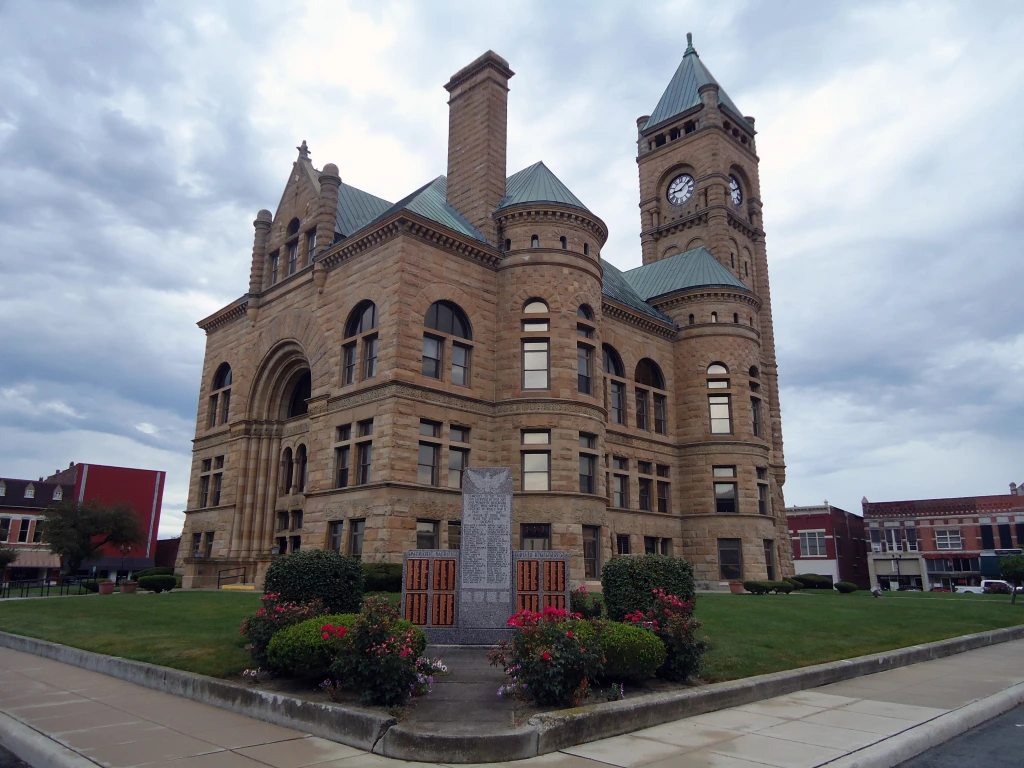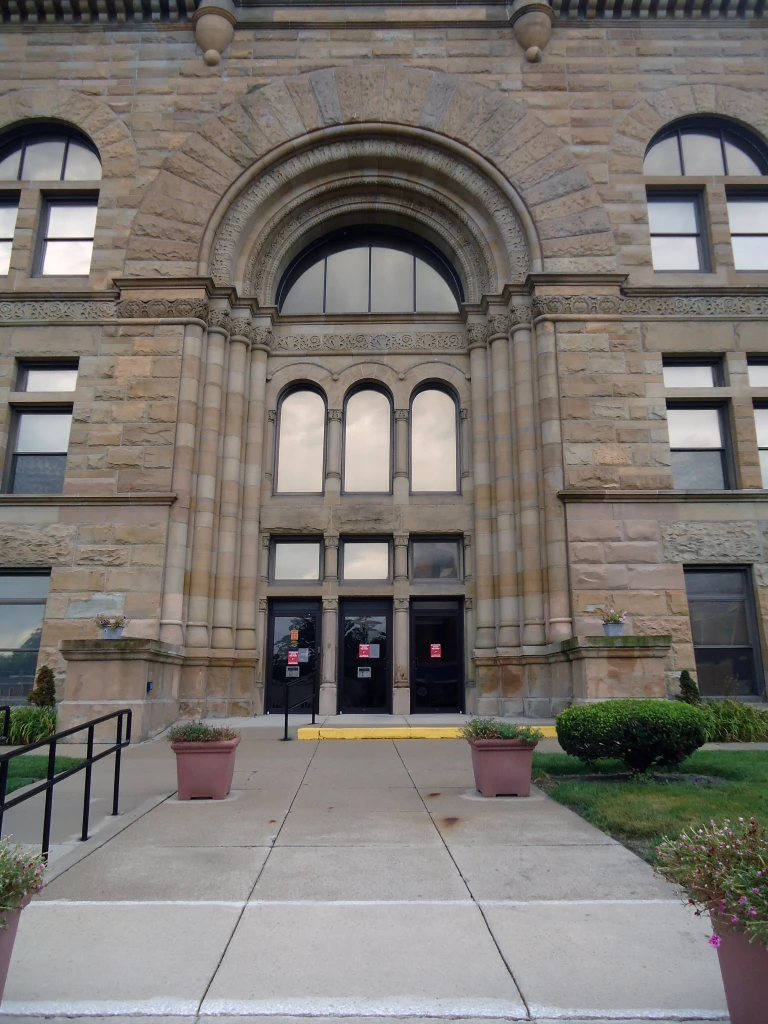Legacy in Stone
By: Ted Shideler
Although it’s been long since bypassed by the interstate, Indiana State Road 3 still provides a scenic route through the countryside of northeastern Indiana that can be traveled relatively quickly. I became acquainted with the road from trips to visit family during my childhood, but it took constant weekend drives back home to Muncie from my Fort Wayne apartment to become really close with it. Without question, the highway’s most prominent landmark is the Blackford County Courthouse in Hartford City. I eventually wondered how such an impressive courthouse wound up in a county seat that seemed so . . . ordinary.

I know now that I was being uncharitable, since there’s certainly a story there. Blackford County was founded in 1837, but it didn’t officially exist until the following year when a state house resolution passed that authorized its creation1. Choosing a county seat wouldn’t be as straightforward as a simple legislative proclamation, though: a cutthroat political skirmish soon erupted between the residents of centrally-located Hartford and its rival Montpelier. Although Montpelier’s establishment predated the founding of the county by nearly a year, commissioners repeatedly selected Hartford as the county seat.
But even that wasn’t enough: it took four acts by the Indiana General Assembly to finalize Hartford’s place of prominence. Shortly after it was made the county seat, the town’s name was changed to “Hartford City” once leaders found out about another Hartford in the state2.
Although a modest brick courthouse was constructed in 18433, growth was lean in Blackford’s early years. Back then, the area was mostly acres upon acres of swamp and forest, and all that nature would have to go to provide space for suitable development. As you can imagine, all of the draining and lumberjacking took a while, but as luck would have it, both Hartford City and Montpelier were located right between the prominent cities of Muncie and Fort Wayne. Plans were soon made to build a railroad to connect the two to jump-start progress. It ended up taking more than 20 years to complete the Fort Wayne, Cincinnati, & Louisville Railroad4, and growth still wasn’t incendiary.

But then, something inflammatory happened. In 1876, a group of backwoods entrepreneurs in nearby Eaton was earnestly drilling a hole in search of some coal to mine. They got as deep as 600 feet down when, shockingly, a screeching noise and horrific odor erupted from the pipe! Absolutely sure that they’d breached the ceilings of Hell, the miners quickly plugged everything up and scattered, vowing never to drill in that location again. When natural gas was discovered across the border in Ohio a few years later, residents remembered what had happened and re-opened the well. More were drilled in short order, and the Indiana Gas Boom was underway.
The boom spread across the region, and although prospectors in Blackford County took their sweet time, they finally struck oil just south of Montpelier in 18905. Incredibly, the sleepy county with only 8,020 residents sat above the center of the 5,120-square-mile Trenton Gas Field! The field contained more than a trillion cubic feet of natural gas and another billion barrels of oil. Naturally, industry jumped on this development, and Blackford County was in a perfect position to capitalize on it. Glass manufacturers in need of cheap power and heat moved in right away, and gas companies sprung up in nearly every town in the county.
In 1880 the county only had 171 people working in the manufacturing sector. By 1901 – only two decades later – 1,346 were employed. Hartford City’s population went up, too. Per the census, 1,470 people made their homes in the sleepy county seat in 1880. However, the influx of manufacturers rocketed Hartford City’s population to nearly 6,000 at the close of the century. That’s a 214% increase!

County officials knew that a certain responsibility came with being located in the middle of a gas field the size of Connecticut, so they set out to prove that Hartford City could stand head-to-head with the other gas boom county seats. To stake that claim, commissioners decided to build the grandest courthouse in the area. The sandstone building, finished in 1894, dominates the city square by rising three stories, not counting the pairs of semicircular turrets on its east and west sides or the 165-foot-tall clock tower. It cost $129,337 to build, which equated to approximately $3.72 million in 2016. Architects LaBelle & French designed the courthouse in the popular Richardson Romanesque style that epitomized the sense of permanency officials believed would embody the county’s economic successes for years to come.
History proved the local officials wrong, however. Shortly after the courthouse was completed, the boom began to show signs of slowing, despite urgent attempts by the state legislature to regulate the gas field’s use. By 1902, nearly 90% of the fuel had been squandered through wasteful practices such as lighting flambeaus, defiant torches that signified that the gas was still flowing.By the turn of the century, the displays had become noticeably weaker6, and they began to peter out as the gas supply was exhausted.
Blackford County petered out, too. Once the gas was gone, businesses didn’t have much reason to stay. Most closed up shop or moved out entirely, with only a few exceptions. About 115 years later, there aren’t a lot of relics from the gas boom left in Blackford County. Hartford City and Montpelier are the only cities left. Roll, Trenton, and Millgrove – former boomtowns all – now exist largely in name only. They dried up soon after the gas field did.
Still, the Blackford County Courthouse is unquestionably a reminder of the gas boom as it towers incongruously over Hartford City’s downtown. Whether seen up close, in passing, or from afar, the building serves to remind us all of an aspirational time in our state’s history.

Sources Cited
1 Indiana State House of Representatives. “Journal of the House of Representatives of the State of Indiana during the Twenty-Second Session of the General Assembly”. Indianapolis. Bolton and Livingston. 1837. Print.
2 Biographical and Historical Record of Jay and Blackford Counties, Indiana. Chicago. The Lewis Company. 1887. Print.
3 Enyart, David. “Blackford County” Indiana County Courthouse Histories. ACPL Genealogy Center, 2010-2018. Web. March 30, 2018.
4 A History of Blackford County, Indiana, 1838-1986. Hartford City, Indiana. Blackford County Historic Society. 1986. Print.
5 “Annual Report” Indianapolis Indiana Department of Geology and Natural Resources. 1897. Print.
6 Glass, J. & Kohrman, David. The Gas Boom of East Central Indiana. Charleston. Arcadia Publishing. 2005. Print.




